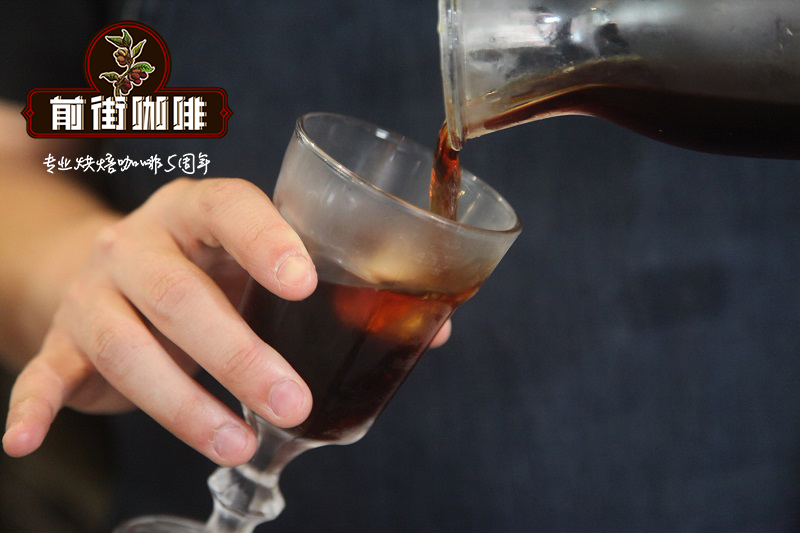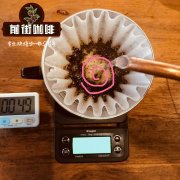The helpless reality of Asian Coffee _ the Price of Asian Coffee beans _ the present situation of Coffee Trade in Asia

Professional coffee knowledge exchange more coffee bean information please follow the coffee workshop (Wechat official account cafe_style)
One cup in the morning awakens the brain, one cup in the afternoon, and one drink in the evening is attitude. At the moment of cup after cup, the consumption of coffee beans in Asia has surpassed that of Europe and the United States, ranking first in the world. It is a veritable "black gold" and has set off trillion yuan business opportunities all over the world. In Taiwan alone, there is a market size of NT $6 to NT $80 billion. Tea concession, wine flicker. Coffee, a fashionable drink in the hands of Asians, drinks not only much but also well, from production, planting, baking and brewing to brand marketing and talent culture. Do you smell the huge business opportunities facing your nostrils?
● coffee flows through, ironing out the wrinkles in my heart.
Half of the white-collar workers in the city, half of the pink-collar maids on the street, and the youth of most of the students are equipped with a cup of black or brown liquid.
The drink is challenging wine in Europe, cola in America and tea in Asia.
Drinking coffee is never just a matter of drinking a drink. "it's a symbolic personal habit and a social lubricant," Anthony Giddens, a British sociologist, points out. Two people who meet for coffee may be more interested in chatting together than what they actually drink.
As early as the second ○ in 2011, the business news website "Business Insider" pointed out that coffee has exceeded important materials such as gold and natural gas, and its global value is as high as US $100 billion, or NT $3 trillion, second only to oil.
● in recent years, the price of coffee has gone up even higher. At the end of last year, the price of crude oil continued to fall, but the supply of coffee decreased due to drought, and the price soared, making it a veritable "black gold".
The golden age of Asian coffee is quietly unveiled when you and I are cup after cup. Asia, which used to drink tea, not only began to drink coffee, but also began to grow coffee, roast coffee, run coffee brands, and form a coffee culture. You and I are the hosts of this coffee feast, whether we are holding three-in-one instant cans or Laos Paksong boutique coffee, which is comparable to Jamaican Blue Mountain coffee.
Coffee is in place in Asia, from production to consumption. Asian countries have played different roles in origin, technology, brand, market and culture, making consumers fresh and greedy and making entrepreneurs excited.
The International Coffee Organization (ICO) held the 50th anniversary meeting of the second ○ in London in 2013 to publish consumption reports specifically for the fast-growing Asian market. ICO points out that the hot drink market in Asia used to be dominated by tea, but since 1999 ○, it has become the most dynamic growth area for coffee consumption. Over the past 15 years, it has been growing at an annual rate of 4.9%, making it the most eye-catching key coffee market in the world.
ICO surveys 16 countries in East and Southeast Asia, naming Japan, Taiwan and South Korea as having high demand for Arabica coffee and specific coffee (boutique coffee). Indonesia, the Philippines, Thailand and Malaysia are mainly in demand for robusta coffee (instant and canned coffee). (see 91-page mini dictionary)
● consumption in China is growing by 1 ○% per year.
Coffee consumption in China, Asia's largest market, continues to grow at a rate of 1 ○ per cent a year. However, according to the current per capita coffee consumption in China is only 47.6 grams, compared with 2.2 kilograms per capita in Hong Kong, China, with a population of 1.3 billion, is undoubtedly the brightest future star in the coffee market.
Sixteen countries in East and Southeast Asia, with 31% of the world's population and 29% of GDP, currently account for only 16% of the global coffee market, and the driving force and development of consumption growth are extremely optimistic.
ICO also specifically pointed out in the report that Taiwan's per capita coffee consumption has also increased significantly. The per capita coffee volume of ○ in 2012 has reached one kilogram, and there are more than 10, 000 coffee enterprises. More importantly, the proportion of Arabica bean imports in Taiwan's coffee market ranks first in East and Southeast Asia, accounting for more than 60% of imports since ○○○. This means that Taiwan has gradually developed a mature coffee culture based on the demand for boutique coffee (rather than the frequent use of Robusta's three-in-one instant coffee or canned coffee).
However, these soaring figures are not worth the warm aroma of coffee in Asian cities. The large floor-to-ceiling windows of the chain coffee brand occupy the street intersection, while the independent cafe is quietly hidden in the alley.
Tokyo, Seoul, Shanghai, Taipei and Ho Chi Minh City have drawn exclamation points belonging to Asian coffee.
● Japan's most mature coffee culture, the third largest importer
Last month, the hottest consumer topic in Japan was "Tokyo, the first overseas market for blue bottle coffee (Blue Bottle Coffee)." In the first week of the opening of the Tokyo branch, there were long queues at the door, and consumers had to wait up to three hours to get a cup of coffee.
Compared with Starbucks, a global coffee giant in Seattle, USA, Blue bottle Coffee, which comes from San Francisco, is regarded as the representative of the third wave of coffee in the United States and has the reputation of "Apple of the coffee industry".
Compared with the first wave of shallow roasted American coffee produced in large quantities, and the second wave of deep baking brought by coffee chains such as Starbucks, the third wave of coffee refers to, consumers began to pay attention to and requirements for coffee origin, processing technology and baking methods.
Blue bottle Coffee, which is regarded as the "soul of the pursuit of coffee," chose Tokyo as its first overseas stop, symbolizing not only the interest of European and American coffee companies in the Asian market, but also the mature coffee culture of Japan.
Japan has always been the third largest coffee importer after the European Union and the United States. In the fierce coffee market, there has been a trend of independent coffee shops declining and chain stores growing in recent years. Doutor Coffee, the largest local coffee chain, has six ○ stores in Japan, while Starbucks, in second place, has three or four ○ stores.
Japan is also Starbucks' first overseas market. In the 18th year after entering Japan, the US headquarters, which used to own 40% of Starbucks in Japan, announced in September last year that it would buy all shares in Starbucks in Japan because Starbucks in Japan was the most profitable in the world.
The Asia-Pacific market has grown for 20 consecutive quarters, and Starbucks opened its 5,000 store in the Asia-Pacific region in late March. When Starbucks held its annual shareholders' meeting in Seattle on March 18, CEO Howard Schultz announced on stage that Starbucks' revenue and profit figures for 2014 had reached an all-time high, and put forward seven major strategies for the new year. John Culver, who runs the Asia-Pacific region, is in charge of reporting exhibition store and operating growth.
"Shanghai has the largest number of Starbucks in the world, and in India we work with the most important local Tata Group. In the next five years, there will be 10,000 stores in the Asia-Pacific region, with an average of one Starbucks around the world every six hours, "when Calver explained to the 3,000 shareholders under the stage, applause and cheers even exceeded the moment when Schutz announced this year's profit figures.
● is exquisite in Taiwan, and every coffee shop has its own ideas.
When the coffee giant, which currently has 22000 stores in the world, is seizing its territory in Asia, Wang Sen, who runs five independent cafes in Wuhan, has also quietly come to Taipei and opened a small cafe with less than 20 seats.
Ask him why he traveled 900 kilometers to Taipei to open a coffee shop. "I like the delicacy of Taiwan. even if you casually walk into a cafe around the corner, there will be no poor quality. there are many coffee baked in your own house, and every coffee shop has its own opinions," observes Wang Sen.
47-year-old Wang Sen, who started running a small coffee shop in Wuhan eight years ago, once owned at most 16 coffee shops with different characteristics at the same time. He has a lot of followers on Weibo, and two ○ published "just want to Open a small Cafe" in 2012, which sold nearly 300000 copies. When he first came to Taipei two years ago, he fell in love with the coffee culture here. He came to Taiwan 38 times in two years.
"Chinese young people also yearn for Xiao Quexing. Not everyone wants to be Xiaomi or Alibaba." Wang Sen's "staggered Coffee Dream School" has trained nearly 1,000 students. He encourages students to return to their hometown in second-and third-tier cities and start in small cafes, and those who want to take classes will have to sign up six months in advance. "the coffee age in China is just about to begin," Wang said.
Korean Wave drinks coffee with you and sells it to the United States.
In the 14th-floor headquarters office of Coffee with you (Caffebene) in Seoul, 47-year-old Chief Executive Kim Sun-Kwon just returned from London four hours ago. "recently, we have also conducted market surveys in Paris, Rome and other places, hoping to enter the European market," he said. (see page 92)
There are already more than 1500 stores around the world. Jin Shanquan, with a gentle smile, is actually impatient. There is an unwritten rule within the company that all signatures are settled within 36 hours, even when he goes abroad to inspect overseas markets twice a month.
Just like the Korean wave that has swept the Asian market in recent years, Korean coffee chains have also come aggressively, relying on celebrity endorsements and combining with South Korean TV series, including coffee company you, Hollys Coffee, A Twosome Place, and so on, to go out of Korea and open branches in Asia, even the Americas, the Middle East, and other places.
When it was only five years old and there were 800 stores in South Korea and the market was saturated, in 2012, Jin Shanquan decided to let coffee accompany you, the largest coffee chain brand in South Korea, out of the country. The first battlefield of choice is not other Asian countries that have been obsessed with Korean Wave for a long time, but New York of the United States.
"the enemy base camp is the best school," Jin Shanquan told the World. He still remembers time magazine saying that Asian countries wanted to come to the United States to sell coffee. "since when did coffee become American? It's just that they did a good job in marketing and developed business, which gave birth to Starbucks. "his success in Korea gave him confidence. Anyway, the world is so complicated that people can try the challenge fearlessly.
Coffee with you has so far invested US $850,000 ○ in the US market and opened 32 stores, but it has not yet made a profit, "but at least it has made Americans drink our Korean coffee." Jin Shanquan has never given up his ambition to expand the exhibition store.
South Koreans who do not grow coffee take their brands out through chain operation, while Vietnamese who specialize in coffee are busy getting on the back seat of the coffee-producing country.
● Vietnam's export market has soared 200 times, the second largest in the world.
Over the past two decades, Vietnam's market share in global coffee exports has jumped from ○. 1% to 2 ○%, surpassing Colombia, a traditional coffee giant, and even lagging behind Brazil. In a year when Brazil's harvest was poor because of the climate, Vietnam was even able to overtake Brazil as the coffee leader. (see page 98)
Ninety-nine percent of the growth engine of Vietnam's coffee industry comes from small farmers with a planting area of less than five hectares. Like the black gold gushing out of the land, coffee has also become the key to changing Vietnam's economy and getting out of the poverty line.
Different from the coffee drinking habits of East Asian countries, coupled with condensed milk mixed with bitter and strong Vietnamese coffee, it is the best partner for Vietnamese to do business, fall in love, and talk about right and wrong. Under the influence of more than 60 years of French colonization, Ho Chi Minh City, with a population of 8 million, has more than 6, 000 coffee shops, with a high density, more than the convenience stores in Taipei. No wonder Vietnam's per capita coffee consumption is no less than that of Taiwan, growing at an annual rate of 1 ○%.
In fact, I don't know who echoed whom, and coffee lovers firmly believe that this little bean has tried its best to bake out the history of human civilization.
When coffee appeared in Britain, it set off the will to fight for national hegemony and conquer the world. It was in the cafe that the French Revolution took vows before it captured the Bastille prison.
When coffee was introduced to Europe by Venice merchants, it became a symbol of urban culture in the 17th century. At the beginning of the 20th century, scholars and scholars gathered in cafes. With the aroma in the air, coffee became a fashionable drink for knowledge dissemination and debate on public issues.
In the 21 century, coffee became the representative of global culture and reached the peak of the craze. Unexpectedly, coffee consumption in Asia surpassed that of the world and became the top of the five continents.
This cup of coffee, which people are used to, has gone through a series of historical, economic and social development to reach everyone. Like alcohol, it is a generally accepted stimulant. This, described by Giddens as a "remarkable and extraordinary phenomenon of globalization", has undoubtedly opened up huge business opportunities in the coffee market.
And this wave of Asian coffee, with or without sugar, will be sweet.
● Asian Coffee Bean Brand recommendation
Asian coffee beans roasted in Qianjie Coffee: Yunnan small Coffee, Yemeni Mocha Coffee, Indonesian Manning Coffee, etc., are fully guaranteed in brand and quality. And more importantly, the performance-to-price ratio is extremely high, a pack of half a pound 227 grams, the price is only 80-90 yuan. According to the calculation of 15 grams of powder per cup of hand-brewed coffee, 15 cups of coffee can be made in a bag, and each cup of coffee costs only about 6 yuan, which is very cost-effective for coffee shops to sell dozens of yuan a cup.
Qianjie coffee: Guangzhou bakery, the store is small but a variety of beans, you can find a variety of unknown beans, but also provide online store services. Https://shop104210103.taobao.com
Important Notice :
前街咖啡 FrontStreet Coffee has moved to new addredd:
FrontStreet Coffee Address: 315,Donghua East Road,GuangZhou
Tel:020 38364473
- Prev

How much is the best coffee in Asia? Asian coffee bean brand recommendation _ Asian bean flavor characteristics
Professional coffee knowledge exchange more coffee bean information Please pay attention to the coffee workshop (Wechat official account cafe_style) Asian coffee beans generally contain a strong herbal flavor, we also often use earthy or earth-like to describe its aroma; its thick body, it is easy to feel its rich body, relatively low acidity is not obvious. According to the Financial Daily, China
- Next

What brand of Asian coffee tastes good? introduction to the flavor characteristics of Asian coffee? are Asian coffee beans expensive?
Coffee workshop (Wechat official account cafe_style) Coffee is produced in more than 60 countries around the world, mostly in the tropics and subtropics between the Tropic of Cancer due to geological and climatic requirements, with an average temperature above 20 ℃ and about 1500 meters above sea level. This coffee growing area is called coffee.
Related
- Does Rose Summer choose Blue, Green or Red? Detailed explanation of Rose Summer Coffee plots and Classification in Panamanian Jade Manor
- What is the difference between the origin, producing area, processing plant, cooperative and manor of coffee beans?
- How fine does the espresso powder fit? how to grind the espresso?
- Sca coffee roasting degree color card coffee roasting degree 8 roasting color values what do you mean?
- The practice of lattes: how to make lattes at home
- Introduction to Indonesian Fine Coffee beans-- Java Coffee producing area of Indonesian Arabica Coffee
- How much will the flavor of light and medium roasted rose summer be expressed? What baking level is rose summer suitable for?
- Introduction to the characteristics of washing, sun-drying or wet-planing coffee commonly used in Mantenin, Indonesia
- Price characteristics of Arabica Coffee Bean Starbucks introduction to Manning Coffee Bean Taste producing area Variety Manor
- What is the authentic Yega flavor? What are the flavor characteristics of the really excellent Yejasuffi coffee beans?

